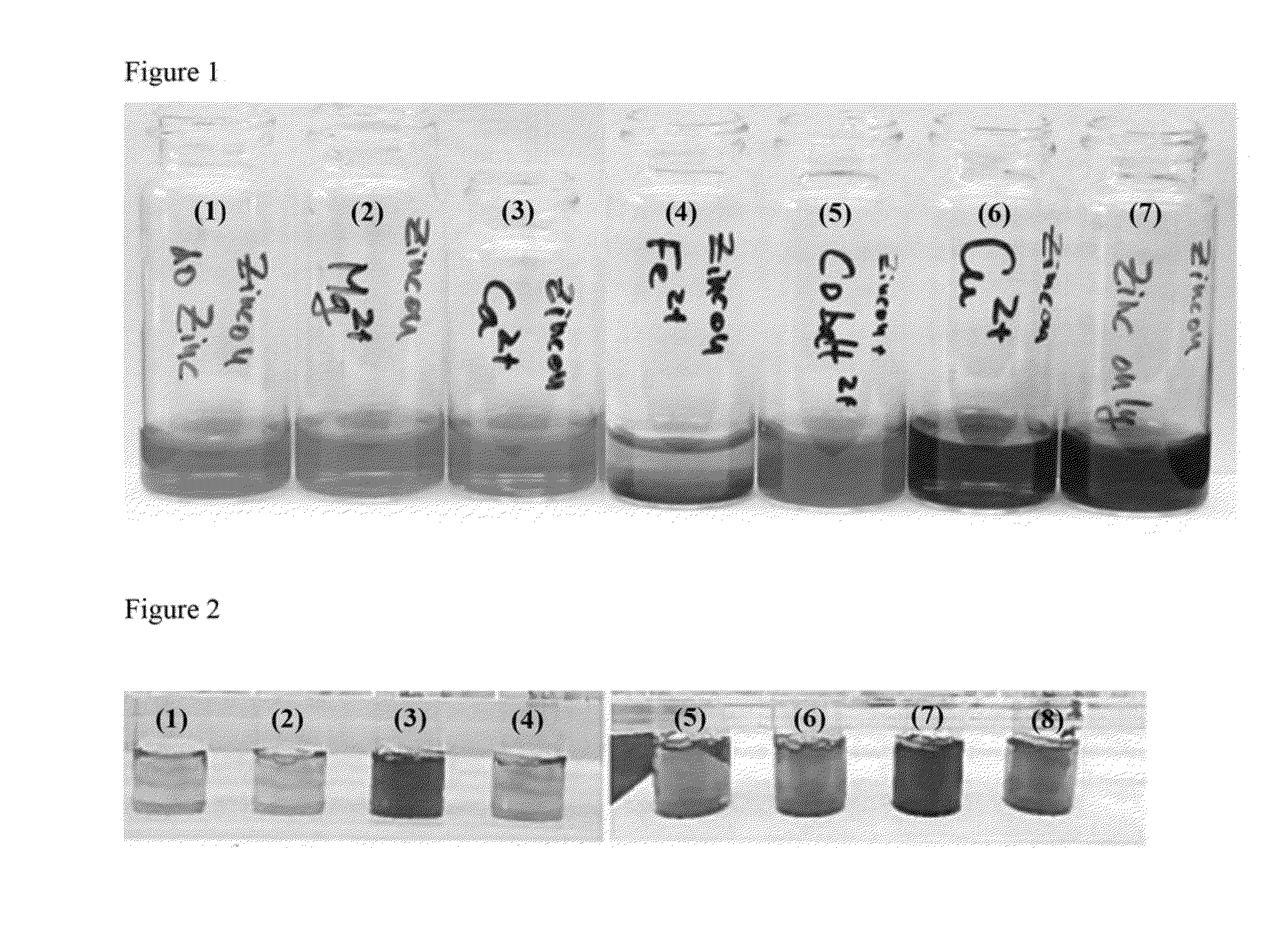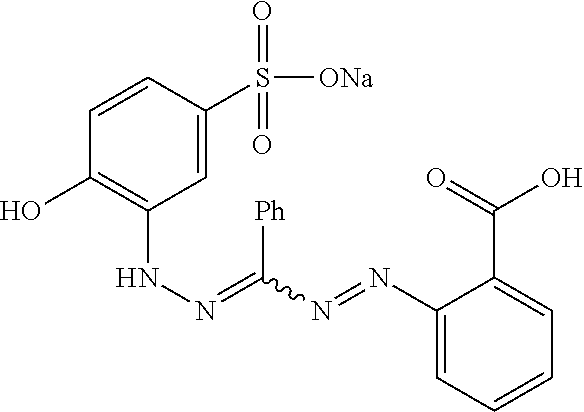Determining the bioavailability of zinc (II) ions
a bioavailability and zinc technology, applied in the field of determining the bioavailability of zinc (ii) ions, can solve the problems of limiting the availability of zinc, the inability of a composition to release zinc (ii) is not readily predictable, and the composition's ability to release zinc (ii) is not easily predictabl
- Summary
- Abstract
- Description
- Claims
- Application Information
AI Technical Summary
Benefits of technology
Problems solved by technology
Method used
Image
Examples
reference example 1
Use of Zincon to Predict Antibacterial Activity
[0069]To illustrate that zincon is useful for the detection of bioavailable zinc (II) ions, the reaction of zincon with Zn2+ in the presence of various ligands was investigated. It was found in subsequent cell viability assays that ligands which prevented or inhibited the reaction between Zn2+ and zincon showed weaker antibacterial activity than those which did not.
[0070]An indicator was prepared by dissolving zincon sodium salt in a 0.2 M ammonia buffer. The pH of the buffer was 9.25. The amount of zincon sodium salt present in the indicator was 0.3% by weight. A series of test solutions was then prepared. Each test solution included 2 to 3 mL, of deionised water, 1 mL of ammonia buffer, and 40 μL of the indicator solution. The remaining components of the solution are set out in Table 1:
TABLE 1solutions investigated. Ligands A to C are each candidatematerials for inclusion in an oral care composition.AdditiveSolution 1NoneSolution 2100...
reference example 2
Reactions of Zincon with Various Metal Ions
[0076]Certain dyes used to detect zinc ions also react with other metal ions. For example, Erioehrome Black T reacts with Mg2+ and Ca2+ ions, which are commonly encountered in biological tissues. Sources of calcium ions are frequently included in oral care compositions. Hence, there would be a risk of false positives if this dye were to be used as an indicator for zinc released from oral care compositions. In order to illustrate that zincon displays good selectivity for zinc, solutions comprising, zincon and various metal ions were prepared.
[0077]The solutions investigated are set out in Table 3:
TABLE 3metal ions investigatedSolutionMetal ion1None2Mg2+3Ca2+4Fe2+5Co2+6Cu2+7Zn2+
[0078]A photograph of the solutions is shown in FIG. 1. Vials containing solutions 1 to 7 are shown from left to right.
[0079]Zincon did not undergo a colour change in the presence of Mg2+ or Ce2+, suggesting that no complex is formed between zincon and these ions. It i...
reference example 3
Effect of pH on the Detection of Zinc (II) Using Zincon
[0083]It has been reported in the literature that the working pH range for zincon is pH 8.5 to 9.5 (Yoe and Rush, 1952. “A new colorimetric reagent for zinc”, Analytica Chimica Acta, vol. 6, pp 526 to 527). Experiments were conducted to illustrate that zincon may be used at pHs outside this range.
TABLE 4absorbance of zincon as function of pHpHAbsorbance of blank at 610 nmAbsorbance of sample at 610 nm7.00.0400.2337.50.0360.2328.00.0350.2458.50.0360.2519.50.0350.252
[0084]As shown in the table above, zinc was detected successfully at all of the pHs investigated.
[0085]Further experiments were conducted using oral care compositions.
[0086]Four toothpaste compositions (compositions W, X, Y and Z) each containing at least one zinc source were prepared. The compositions were dispersed in deionised water to form slurries. The ratio of the toothpaste composition to deionised water, by weight, was 1:2. The slurries were centrifuged for 10 ...
PUM
| Property | Measurement | Unit |
|---|---|---|
| pH | aaaaa | aaaaa |
| pH | aaaaa | aaaaa |
| pH | aaaaa | aaaaa |
Abstract
Description
Claims
Application Information
 Login to View More
Login to View More - R&D
- Intellectual Property
- Life Sciences
- Materials
- Tech Scout
- Unparalleled Data Quality
- Higher Quality Content
- 60% Fewer Hallucinations
Browse by: Latest US Patents, China's latest patents, Technical Efficacy Thesaurus, Application Domain, Technology Topic, Popular Technical Reports.
© 2025 PatSnap. All rights reserved.Legal|Privacy policy|Modern Slavery Act Transparency Statement|Sitemap|About US| Contact US: help@patsnap.com


